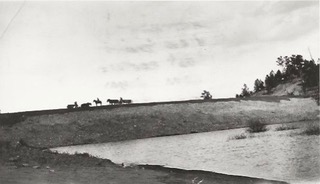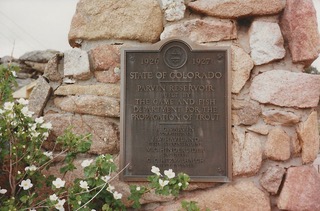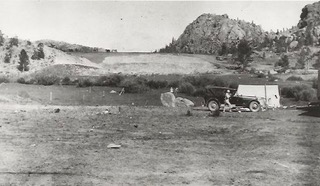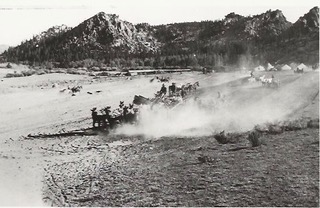 Parvin Lake located near Red Feather Lakes is a Division of Wildlife Research. In the early 1920’s, the State Game and Fish decided to look for an ideal place for raising their own trout eggs, due to the scarcity and high cost of purchasing them. The site chosen was the 160 acres homesteaded by Martin Peterson. The State Game and Fish purchased the property in 1925, as this was an ideal spot for a spawning reservoir. The reservoir would be filled by damming up the Lone Pine Creek east of Red Feather Lakes.
Parvin Lake located near Red Feather Lakes is a Division of Wildlife Research. In the early 1920’s, the State Game and Fish decided to look for an ideal place for raising their own trout eggs, due to the scarcity and high cost of purchasing them. The site chosen was the 160 acres homesteaded by Martin Peterson. The State Game and Fish purchased the property in 1925, as this was an ideal spot for a spawning reservoir. The reservoir would be filled by damming up the Lone Pine Creek east of Red Feather Lakes.
 The reservoir was planned by State Game and Fish Commissioner, R. G. Parvin. It was accessible through Log Cabin via the Poudre Canyon. A forty-five man crew constructed the dam with horse and wagon teams, completing the project by 1926. A caretakers home was also built. Abe Akin lived in it.
The reservoir was planned by State Game and Fish Commissioner, R. G. Parvin. It was accessible through Log Cabin via the Poudre Canyon. A forty-five man crew constructed the dam with horse and wagon teams, completing the project by 1926. A caretakers home was also built. Abe Akin lived in it.
The lake was first stocked with 1 million rainbow trout eggs. It was used as a fish hatchery, producing over 30 million eggs a year. The eggs were collected and shipped by Franklin oxygenated trucks to other parts of the state.
By 1945, Parvin Lake had so many fish that it was open to the public for fishing. It was used to evaluate fishing with flies and lures only. It worked so well that the state adopted the regulation at other lakes in Colorado. The lake was stocked with several other types of fish to see how they would acclimate. The Fish Hatchery was closed in 1980, and the lake was opened to fishing.
In 2003, the hatchery was opened as a research station to test different strains of fish for whirling disease. It is also used to test strains of fish to see which strains are best suited for lakes and streams.
Parvin Lake by Michael G. Braa (Mickey)
Your brief summary history of Parvin is okay but a wee bit off base in places. So below is a bit of clarification off the top of my head. My father (Calvin G. Braa) was the resident manager of Parvin Lake for 4 years in the early to mid 60’s and my parents retired to Red Feather in 1984 before moving to Loveland in 2005.
 And…of course to create the lake they built two dams—the north side one and the east side one which includes the outlet into the Lone Pine Creek. Although Parvin was built with mixed purposes including a fish hatchery and spawning program, long term limnology research projects also took place at Parvin, especially reaching their peak in the 1960’s—the whirling disease study, water quality and insect studies, as well as some breeding and genetic projects including monitoring, sampling and tagging test populations of “Splake” fish, a cross between lake and brook trout, as well as a population of Kokone Salmon. There were fish traps at both the creek inlet and outlet to prevent outside fish in and inside fish populations from getting out. A daily task was to remove trapped fish, weigh, measure, inspect and prep for relocation either back into Parvin or into the creek below the outlet.
And…of course to create the lake they built two dams—the north side one and the east side one which includes the outlet into the Lone Pine Creek. Although Parvin was built with mixed purposes including a fish hatchery and spawning program, long term limnology research projects also took place at Parvin, especially reaching their peak in the 1960’s—the whirling disease study, water quality and insect studies, as well as some breeding and genetic projects including monitoring, sampling and tagging test populations of “Splake” fish, a cross between lake and brook trout, as well as a population of Kokone Salmon. There were fish traps at both the creek inlet and outlet to prevent outside fish in and inside fish populations from getting out. A daily task was to remove trapped fish, weigh, measure, inspect and prep for relocation either back into Parvin or into the creek below the outlet.
 The original 20’s era fish hatchery was built below/behind the north (1st) dam, fell into total ruin and was rebuilt by my father in the same location in about 1965 to resume limited special hatchling/fingerling fish studies and then small scale distribution to stocking programs. The building pictured on your website is the laboratory/research building with boat house that was built in about 1964 to provide for on-site lake netting and lab studies and samples preparation that had for years had to be sent to Ft. Collins for this. The rebuilt hatchery was also abandoned after only a few years and was more or less abandoned by 1970 and has since also been razed.
The original 20’s era fish hatchery was built below/behind the north (1st) dam, fell into total ruin and was rebuilt by my father in the same location in about 1965 to resume limited special hatchling/fingerling fish studies and then small scale distribution to stocking programs. The building pictured on your website is the laboratory/research building with boat house that was built in about 1964 to provide for on-site lake netting and lab studies and samples preparation that had for years had to be sent to Ft. Collins for this. The rebuilt hatchery was also abandoned after only a few years and was more or less abandoned by 1970 and has since also been razed.
Parvin Lake was always open to controlled fishing (flies and artificial lures only), no boats, for approximately 4-5 months of the year (May thru September). Fisherman were required to park at the gate lot and access and exit the lake through a check station at the lake entrance where visitor/fishermen demographic data and statistical/tag/and physical data on fish caught was gathered and recorded. In 1980 the lake was opened to year-round uncontrolled fishing and small craft like canoes–and I believe public vehicles are still not allowed into the lake property, and the check station data collection is still operated during certain seasons.
The last time I visited Parvin in approx. 2008, that 1960’s lab facility was still left abandoned and more or less open/unsecured as it had for at least the prior 20 years. I had to laugh, as the old typewriter-like electric statistical calculation machine that my father labored with was still sitting on a deteriorating office counter…..After the major projects wound down in the late 1960, the lab was mostly left idle with some minor storage of field equipment. The housing at Parvin was then used/rented by a succession of non-fisheries personnel including game wardens and county deputies.
The original fenced residential/project compound which was nicely hardscaped and laid-out, included a large house, a 4-vehicle oversized garage, a crew bunkhouse, a small two-slot boathouse, a well house and several small storage buildings—all featuring the same stucco exteriors. All but the orig. house, garage and bunkhouse were razed when the lab facility was constructed in the 60’s—and the attractive low stonework drives and barrier walls or the compound and grounds were more or less leveled.
The orig. 1920’s stucco house and garage had burned a few years after we moved away (we left in 66) and was razed. My father had take a new position as the maintenance manager of first Cherry creek Reservoir in Denver and then for state lake and park areas on the Western Slope. A newer house was built at Parvin sometime in the early 70’s?—which is often left vacant. The small original bunkhouse, also stucco was the only remaining original building at Parvin the last I was there—although it may also now be gone? I will have to visit this year to see!